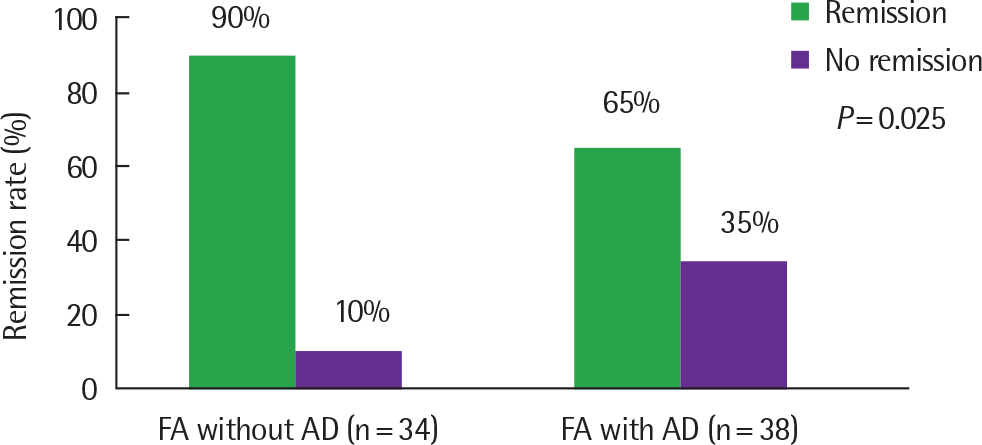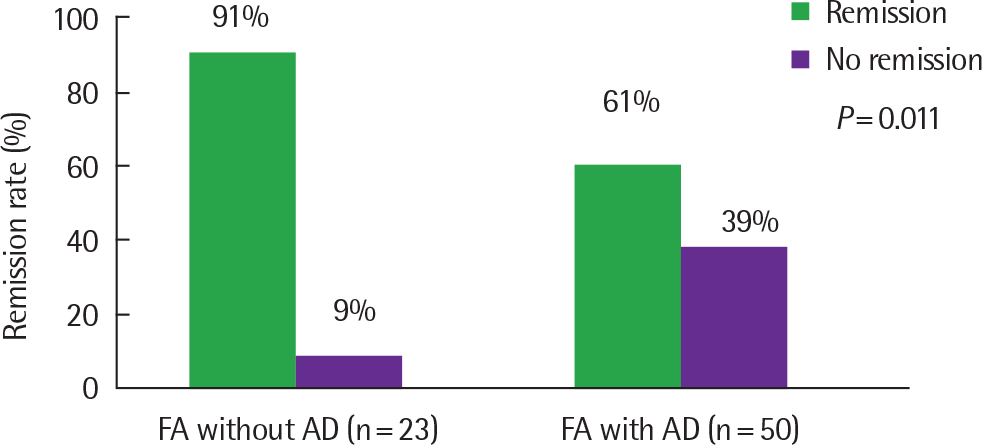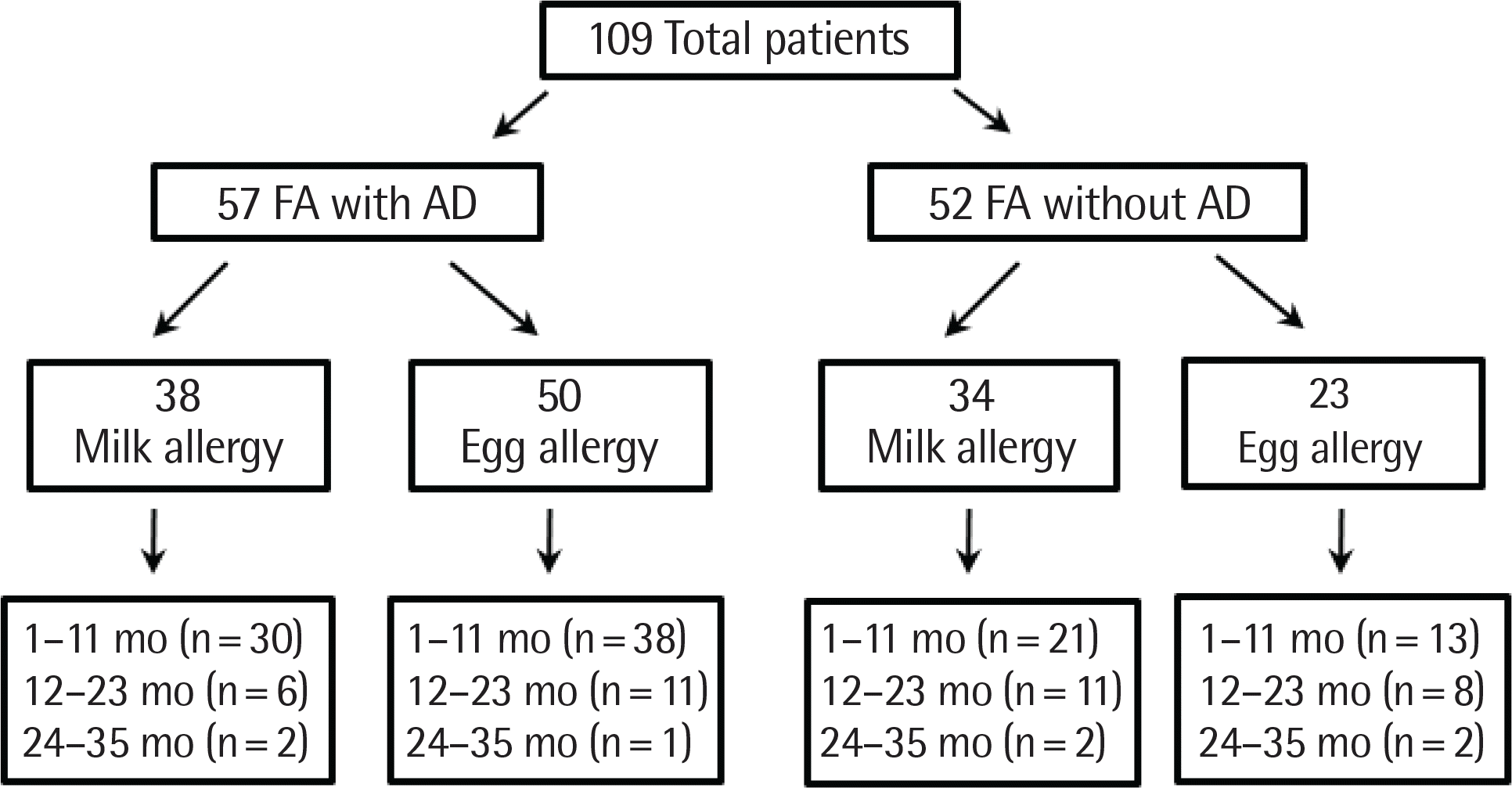Abstract
Purpose
There have been studies showing that food allergy plays a role in the pathogenesis of atopic dermatitis. However, there have been few studies about the effect of atopic dermatitis on remission of food allergy. Thus, this study aimed to evaluate the difference in remission according to the presence of atopic dermatitis in infants and young children with milk or egg allergy.
Methods
A retrospective study was performed on 109 infants and young children with IgE-mediated food allergy in a tertiary hospital. They divided into food allergy with atopic dermatitis (FA with AD) and without atopic dermatitis (FA without AD).
Results
In the milk allergy group, initial milk-specific IgE levels were 21.16±27.98 kU A/L and 11.36±22.88 kU A/L, respectively, in FA with AD and FA without AD under 12 months of age. The remission rates of milk allergy at 36 months of age were 64.9% and 90.0%, respectively, in FA with AD and FA without AD. In the egg allergy groups, initial egg-specific IgE levels were 34.48±36.72 kU A/L and 15.66±28.60 kU A/L, respectively, in FA with AD and FA without AD under 12 months of age. The remission rates of egg allergy at 36 months of age were 61.2% and 90.0% in children with FA with AD and FA without AD.
Go to : 
REFERENCES
1. Leung DY, Sicherer SH. Atopic dermatitis (atopic eczema). Kliegman R, Stanton B, St Geme J, Schor N, editors. Nelson textbook of pediatrics. 20th ed.Philadelphia: Elsevier;2015. p. 1116–21.

2. Schloss OM. Allergy to common foods. Trans Am Pediatr Soc. 1915; 27:62–8.
3. Sicherer SH, Sampson HA. Food hypersensitivity and atopic dermatitis: pathophysiology, epidemiology, diagnosis, and management. J Allergy Clin Immunol. 1999; 104(3 Pt 2):S114–22.

4. Burks AW, James JM, Hiegel A, Wilson G, Wheeler JG, Jones SM, et al. Atopic dermatitis and food hypersensitivity reactions. J Pediatr. 1998; 132:132–6.

5. Kelleher MM, Dunn-Galvin A, Gray C, Murray DM, Kiely M, Kenny L, et al. Skin barrier impairment at birth predicts food allergy at 2 years of age. J Allergy Clin Immunol. 2016; 137:1111–6.e8.
6. Dunkin D, Berin MC, Mayer L. Allergic sensitization can be induced via multiple physiologic routes in an adjuvant-dependent manner. J Allergy Clin Immunol. 2011; 128:1251–8.e2.

8. Hanifin JM, Rajka G. Diagnostic features of atopic eczema. Acta Dermatol Venereol Suppl (Stockh). 1980; 92:44–7.
9. Flohr C, Perkin M, Logan K, Marrs T, Radulovic S, Campbell LE, et al. Atopic dermatitis and disease severity are the main risk factors for food sensitization in exclusively breastfed infants. J Invest Dermatol. 2014; 134:345–50.

10. Du Toit G, Roberts G, Sayre PH, Plaut M, Bahnson HT, Mitchell H, et al. Identifying infants at high risk of peanut allergy: the Learning Early About Peanut Allergy (LEAP) screening study. J Allergy Clin Immunol. 2013; 131:135–43.e1-12.

11. Tsakok T, Marrs T, Mohsin M, Baron S, du Toit G, Till S, et al. Does atopic dermatitis cause food allergy? A systematic review. J Allergy Clin Immunol. 2016; 137:1071–8.

12. Hill DJ, Hosking CS. Food allergy and atopic dermatitis in infancy: an epidemiologic study. Pediatr Allergy Immunol. 2004; 15:421–7.

13. Pourpak Z, Farhoudi A, Mahmoudi M, Movahedi M, Ghargozlou M, Kazemnejad A, et al. The role of cow milk allergy in increasing the severity of atopic dermatitis. Immunol Invest. 2004; 33:69–79.

14. Pourpak M, et al. The study of egg allergy in children with atopic dermatitis. World Allergy Organ J. 2009; 2:123–7.
15. Spergel JM, Boguniewicz M, Schneider L, Hanifin JM, Paller AS, Eichen-field LF. Food allergy in infants with atopic dermatitis: limitations of food-specific IgE measurements. Pediatrics. 2015; 136:e1530–8.

16. Novak N, Bieber T, Leung DY. Immune mechanisms leading to atopic dermatitis. J Allergy Clin Immunol. 2003; 112(6 Suppl):S128–39.

Go to : 
 | Fig. 2.Remission rate of milk allergy at 36 months of age. FA, food allergy; AD, atopic dermatitis. |
 | Fig. 3.Remission rate of egg allergy at 36 months of age. FA, food allergy; AD, atopic dermatitis. |
Table 1.
Characteristics of subjects
| Characteristic | FA with AD (n=57) | FA without AD (n=52) | P-value |
|---|---|---|---|
| Age that diagnosed with FA (mo) | 9 | 10 | 0.91 |
| Sex | 0.74 | ||
| Male | 37 | 36 | |
| Female | 20 | 16 | |
| Delivery type | 0.46 | ||
| Vaginal delivery | 35 | 36 | |
| C-sec | 22 | 16 | |
| Feeding under 3 month-aged | |||
| Breast milk | 30 | 36 | 0.49 |
| Artificial milk | 27 | 16 | 0.37 |
| History of sibling's FA | 10 | 8 | 0.55 |
| History of sibling's AD | 16 | 4 | 0.36 |
| History of parent's FA | 5 | 2 | 0.33 |
| History of parent's AD | 8 | 3 | 0.40 |
| Milk and egg allergy | 30 | 5 | <0.01∗ |
Table 2.
IgE level in infants and young children with milk allergy
| IgE (kU A/D) | FA with AD | FA without AD | P-value |
|---|---|---|---|
| Under 12 months (n=51) | |||
| Total IgE | 374.60±352.74 | 159.41±247.55 | 0.001∗ |
| Log (Total IgE) | 5.39±1.13 | 3.90±1.66 | |
| Milk IgE | 21.16±27.98 | 11.36±22.88 | 0.017∗ |
| Log (Milk IgE) | 2.14±1.53 | 0.83±2.14 | |
| 12–23 Months (n=17) | |||
| Total IgE | 330.60±316.81 | 131.30±179.60 | 0.119 |
| Log (Total IgE) | 5.29±1.21 | 4.19±1.21 | |
| Milk IgE | 10.79±13.65 | 3.03±4.32 | 0.470 |
| Log (Milk IgE) | 1.06±2.29 | 0.28±1.49 | |
| 24–35 Months (n=4) | |||
| Total IgE | 150.90±110.44 | 72.64±22.96 | 0.206 |
| Log (Total IgE) | 4.86±0.81 | 4.26±0.32 | |
| Milk IgE | 7.32±4.64 | 4.26±0.32 | 0.568 |
| Log (Milk IgE) | 1.88±0.68 | -0.30±1.72 |
Table 3.
IgE level in infants and young children with egg allergy
| IgE (kU A/D) | FA with AD | FA without AD | P-value |
|---|---|---|---|
| Under 12 months (n=51) | |||
| Total IgE | 325.00±326.02 | 159.41±247.55 | 0.001∗ |
| Log (Total IgE) | 5.18±1.26 | 3.51±1.44 | |
| Egg IgE | 38.48±36.72 | 15.66±28.60 | 0.019∗ |
| Log (Egg IgE) | 3.00±1.34 | 0.99±2.27 | |
| 12–23 Months (n=19) | |||
| Total IgE | 218.60±262.43 | 175.40±184.99 | 0.965 |
| Log (Total IgE) | 4.76±1.20 | 4.82±0.83 | |
| Egg IgE | 17.65±28.75 | 40.10±41.36 | 0.212 |
| Log (Egg IgE) | 2.06±1.28 | 2.99±1.40 | |
| 24–35 Months (n=3) | |||
| Total IgE | 499.00±0.00 | 100.40±62.27 | 0.283 |
| Log (Total IgE) | 6.21±0.00 | 4.50±0.66 | |
| Egg IgE | 2.62±0.00 | 1.99±0.72 | 0.617 |
| Log (Egg IgE) | 0.96±0.00 | 0.62±0.37 |




 PDF
PDF ePub
ePub Citation
Citation Print
Print



 XML Download
XML Download